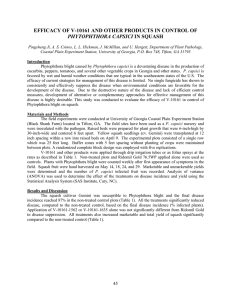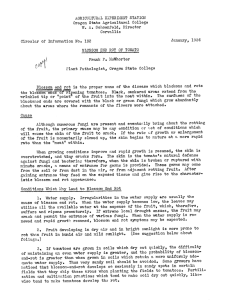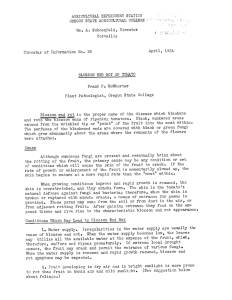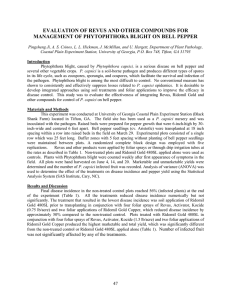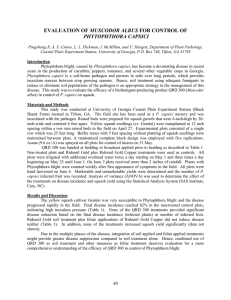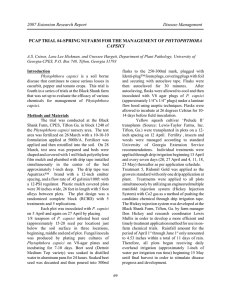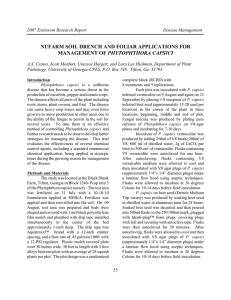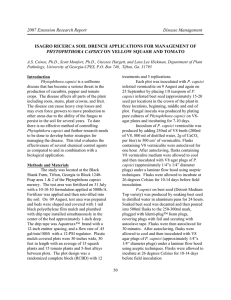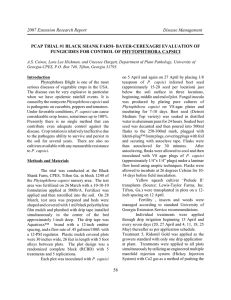EVALUATION OF V-10161 FOR CONTROL OF PHYTOPHTHORA FRUIT ROT
advertisement
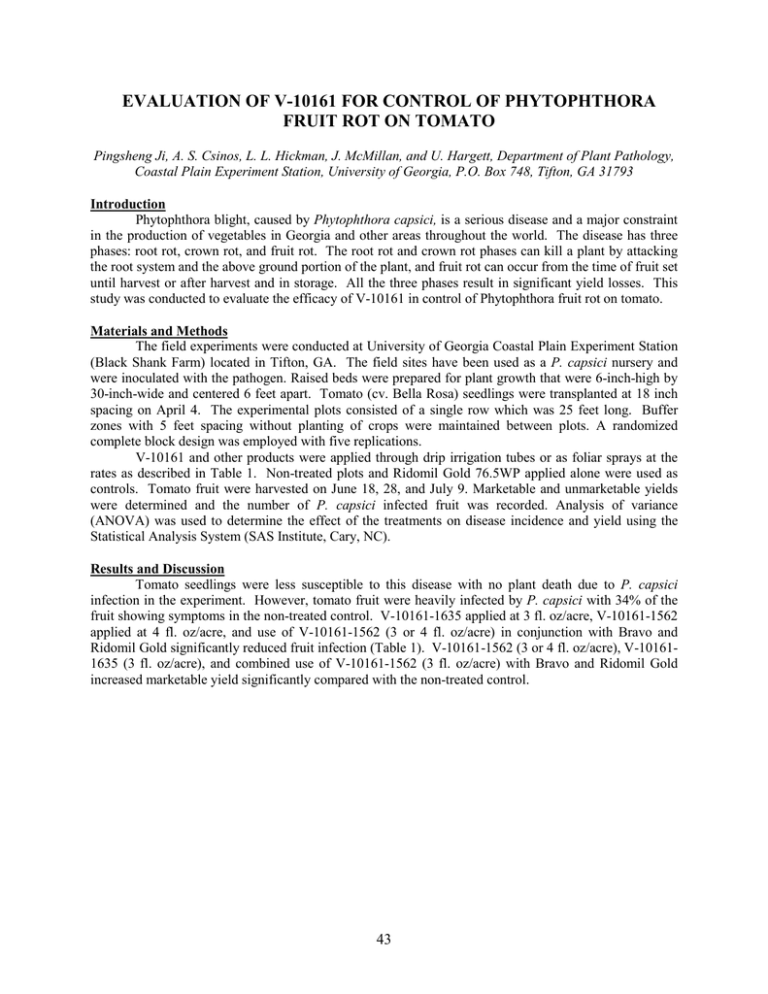
EVALUATION OF V-10161 FOR CONTROL OF PHYTOPHTHORA FRUIT ROT ON TOMATO Pingsheng Ji, A. S. Csinos, L. L. Hickman, J. McMillan, and U. Hargett, Department of Plant Pathology, Coastal Plain Experiment Station, University of Georgia, P.O. Box 748, Tifton, GA 31793 Introduction Phytophthora blight, caused by Phytophthora capsici, is a serious disease and a major constraint in the production of vegetables in Georgia and other areas throughout the world. The disease has three phases: root rot, crown rot, and fruit rot. The root rot and crown rot phases can kill a plant by attacking the root system and the above ground portion of the plant, and fruit rot can occur from the time of fruit set until harvest or after harvest and in storage. All the three phases result in significant yield losses. This study was conducted to evaluate the efficacy of V-10161 in control of Phytophthora fruit rot on tomato. Materials and Methods The field experiments were conducted at University of Georgia Coastal Plain Experiment Station (Black Shank Farm) located in Tifton, GA. The field sites have been used as a P. capsici nursery and were inoculated with the pathogen. Raised beds were prepared for plant growth that were 6-inch-high by 30-inch-wide and centered 6 feet apart. Tomato (cv. Bella Rosa) seedlings were transplanted at 18 inch spacing on April 4. The experimental plots consisted of a single row which was 25 feet long. Buffer zones with 5 feet spacing without planting of crops were maintained between plots. A randomized complete block design was employed with five replications. V-10161 and other products were applied through drip irrigation tubes or as foliar sprays at the rates as described in Table 1. Non-treated plots and Ridomil Gold 76.5WP applied alone were used as controls. Tomato fruit were harvested on June 18, 28, and July 9. Marketable and unmarketable yields were determined and the number of P. capsici infected fruit was recorded. Analysis of variance (ANOVA) was used to determine the effect of the treatments on disease incidence and yield using the Statistical Analysis System (SAS Institute, Cary, NC). Results and Discussion Tomato seedlings were less susceptible to this disease with no plant death due to P. capsici infection in the experiment. However, tomato fruit were heavily infected by P. capsici with 34% of the fruit showing symptoms in the non-treated control. V-10161-1635 applied at 3 fl. oz/acre, V-10161-1562 applied at 4 fl. oz/acre, and use of V-10161-1562 (3 or 4 fl. oz/acre) in conjunction with Bravo and Ridomil Gold significantly reduced fruit infection (Table 1). V-10161-1562 (3 or 4 fl. oz/acre), V-101611635 (3 fl. oz/acre), and combined use of V-10161-1562 (3 fl. oz/acre) with Bravo and Ridomil Gold increased marketable yield significantly compared with the non-treated control. 43 Table 1. Efficacy of V-10161 in control of Phytophthora fruit rot on tomato Yield (lb/A)1 Marketable Total Infected fruit (%)1,2 Non-treated control 14,506 b 22,935 b 34.2 a V-10161-1562 4.0SC, 2 fl. oz/A 19,472 a 29,012 a 30.7 ab V-10161-1562 4.0SC, 3 fl. oz/A 26,137 a 34,239 a 24.8 abc V-10161-1635 4.0SC, 3 fl. oz/A 22,804 a 28,163 a 20.3 c V-10161-1562 4.0SC, 4 fl. oz/A 22,347 a 31,560 a 21.0 bc V-10161-1562 4.0SC, 3 fl. oz/A Bravo 4.17SC, 2.25 pt/A Ridomil Gold 76.5WP, 2 lb/A 23,785 a 31,560 a 20.1 c V-10161-1562 4.0SC, 4 fl. oz/A Bravo 4.17SC, 2.25 pt/A Ridomil Gold 76.5WP, 2 lb/A 21,367 a 27,901 a 21.0 bc Ridomil Gold 76.5WP, 2 lb/A 24,895 a 35,089 a 23.5 abc Treatment and rate 1 Means within a column followed by the same letter are not significantly different (P = 0.05) according to Duncan’s multiple range test. 2 Percentage of P. capsici infected fruit. 44
